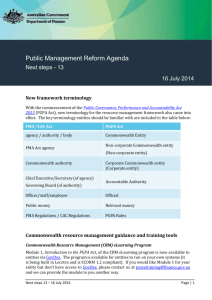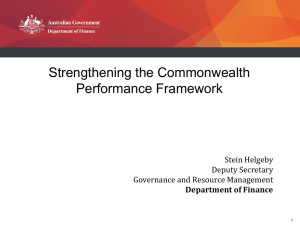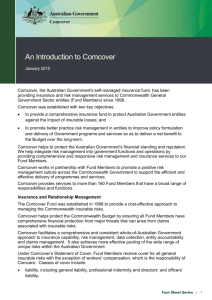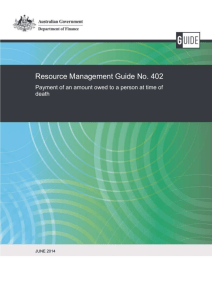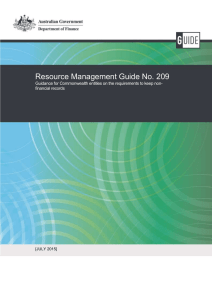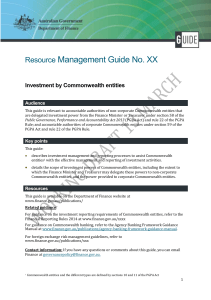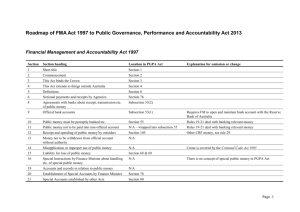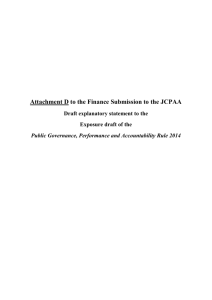Proposed approach to the Performance Framework under the PGPA
advertisement
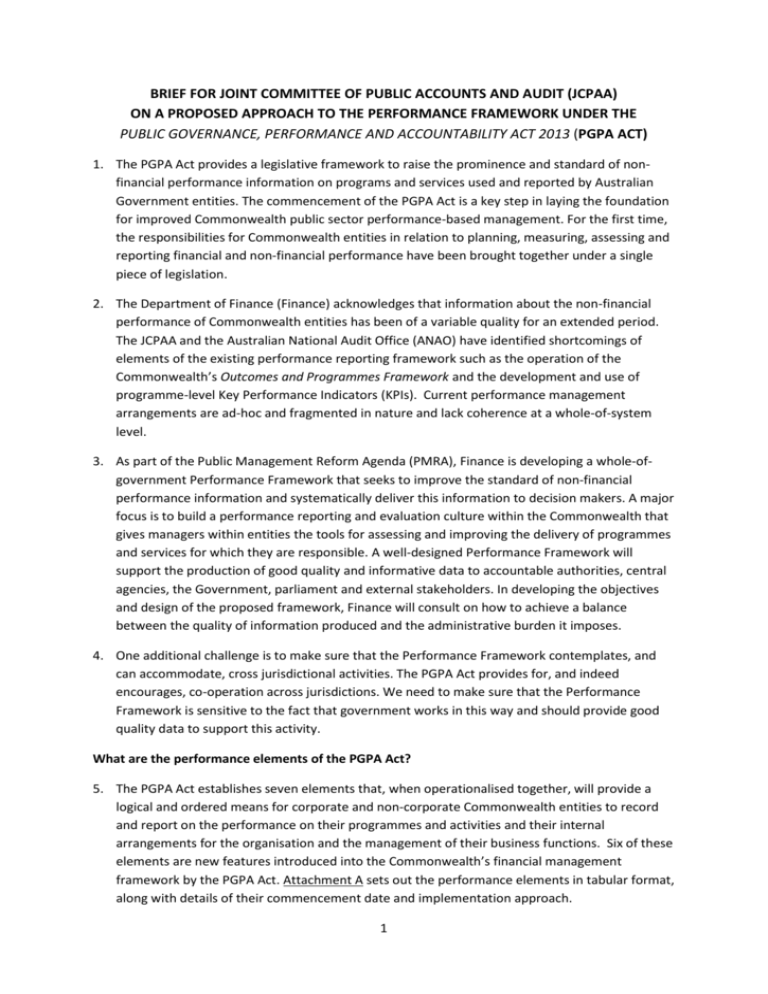
BRIEF FOR JOINT COMMITTEE OF PUBLIC ACCOUNTS AND AUDIT (JCPAA) ON A PROPOSED APPROACH TO THE PERFORMANCE FRAMEWORK UNDER THE PUBLIC GOVERNANCE, PERFORMANCE AND ACCOUNTABILITY ACT 2013 (PGPA ACT) 1. The PGPA Act provides a legislative framework to raise the prominence and standard of nonfinancial performance information on programs and services used and reported by Australian Government entities. The commencement of the PGPA Act is a key step in laying the foundation for improved Commonwealth public sector performance-based management. For the first time, the responsibilities for Commonwealth entities in relation to planning, measuring, assessing and reporting financial and non-financial performance have been brought together under a single piece of legislation. 2. The Department of Finance (Finance) acknowledges that information about the non-financial performance of Commonwealth entities has been of a variable quality for an extended period. The JCPAA and the Australian National Audit Office (ANAO) have identified shortcomings of elements of the existing performance reporting framework such as the operation of the Commonwealth’s Outcomes and Programmes Framework and the development and use of programme-level Key Performance Indicators (KPIs). Current performance management arrangements are ad-hoc and fragmented in nature and lack coherence at a whole-of-system level. 3. As part of the Public Management Reform Agenda (PMRA), Finance is developing a whole-ofgovernment Performance Framework that seeks to improve the standard of non-financial performance information and systematically deliver this information to decision makers. A major focus is to build a performance reporting and evaluation culture within the Commonwealth that gives managers within entities the tools for assessing and improving the delivery of programmes and services for which they are responsible. A well-designed Performance Framework will support the production of good quality and informative data to accountable authorities, central agencies, the Government, parliament and external stakeholders. In developing the objectives and design of the proposed framework, Finance will consult on how to achieve a balance between the quality of information produced and the administrative burden it imposes. 4. One additional challenge is to make sure that the Performance Framework contemplates, and can accommodate, cross jurisdictional activities. The PGPA Act provides for, and indeed encourages, co-operation across jurisdictions. We need to make sure that the Performance Framework is sensitive to the fact that government works in this way and should provide good quality data to support this activity. What are the performance elements of the PGPA Act? 5. The PGPA Act establishes seven elements that, when operationalised together, will provide a logical and ordered means for corporate and non-corporate Commonwealth entities to record and report on the performance on their programmes and activities and their internal arrangements for the organisation and the management of their business functions. Six of these elements are new features introduced into the Commonwealth’s financial management framework by the PGPA Act. Attachment A sets out the performance elements in tabular format, along with details of their commencement date and implementation approach. 1 What is the proposed Performance Framework? 6. Attachment B outlines a draft proposed Performance Framework, which is to be the subject of consultation over the next few months, including how the measuring and assessing (monitoring and evaluation) elements of the PGPA Act can be incorporated into entity and government decision-making processes. This proposed framework is designed to support: an increase in the profile and standard of non-financial performance information to be on par with financial information; an increase in the visibility of the various sources of non-financial performance information about the activities of Commonwealth entities; the production of useful and accurate non-financial performance information about Commonwealth programmes; independent verification of the quality of information agencies produce; the Finance Minister and responsible Ministers accessing information about agency and programme performance; improved decision making by entities about internal operations and programme management; and over time, improved decision making by Government and the Parliament about the design and resourcing of programmes. 7. The draft proposed framework has been designed to improve the profile and integration of nonfinancial performance information through addressing the following components: Conceptualise and Plan - An entity will have the ability to determine how to assess the performance of their programmes, including which ones to evaluate (within PGPA rules and guidance). However, a government decision or legislation can also dictate whether and when an evaluation or other performance measurement activities will be undertaken. The entity will detail in their Corporate Plan (s35) their: o expected performance levels and deliverables; o performance tools and measures selected to determine performance; and o evaluations planned for the period of the Corporate Plan, which should have a time horizon that coincides with the Budget forward estimates. Entities will be required to provide Finance with a list of any evaluations that are of a classified nature which they don’t intend to publicise. Measure and Assess - s37 and s38: An entity will be required to measure and assess (monitor and evaluate) performance and keep proper records to explain both its own performance, as part of delivering its programmes, and the performance or achievements of its programmes. Report and Adjust - s39, s40 and s46: The Annual Performance Statement raises the profile of non-financial performance information to the same level of importance as financial information in the Annual Report of the entity. The Auditor-General may examine and report on an entity’s Annual Performance Statement at the request of a Minister. The Annual Performance Statement reports against the planned objectives of the Corporate Plan, including the outcomes of evaluations concluded before 31 December each year. This would allow entities at least 6 months to implement changes following completion of the 2 evaluation, before they report on the outcome of the evaluation in their Annual Performance Statement. In addition non-corporate entities will be required to provide Finance, Treasury and the Department of the Prime Minister and Cabinet (PM&C) with a copy of all evaluations (including evaluations that are of a confidential nature) plus a progress report 6 months after completing the evaluation. 8. Avenues to address areas of concern about performance-related information: The Act contains several elements that support Government decision-making through verifying information, or enabling access to information, about performance. These include: o o o ss19 (1)a and ss19 (1)b: agencies must provide information to the Finance Minister or responsible Minister as required about their activities; ss37 (3): empowers the Finance Minister, and the responsible Minister, access to information about an entity’s performance as required; and s40: enables the Finance Minister or responsible Minister to request the ANAO to audit an Annual Performance Statement. This would be tabled in Parliament and provides an assurance of the veracity of the performance achievements reported. 9. As part of introducing and supporting the proposed draft Performance Framework, Finance would propose to: Provide well constructed guidance and training on: o o o o key tools and approaches for collecting non-financial performance information, including on the design of key performance indicators and the use of evaluations at different parts of a programme’s cycle; better practice for non-financial performance information and the assessment of Commonwealth programmes; ensuring alignment between the various sources of non-financial performance information and the input (means), process (use), output (performance) or outcome (effects) it is describing; and the options for incorporating the learning from various sources of non-financial information into decisions at various levels within an entity. Increase interactions with entities to support them developing useful and applicable performance measures and metrics. This extends upon Finance’s engagement to date with agencies that has focused on improving their KPIs. 10. Finance would also propose to take on a role in reviewing the information published by agencies and to monitor agencies’ progress in implementing the recommendations in evaluations. Finance has been working, in consultation with the PMRA Planning and Reporting Steering Committee, on issues related to the implementation of the above new elements of the PGPA Act. Finance will continue to engage with this, and other PMRA Committees, on the design and implementation of a whole-of-government approach to performance measurement and reporting. 3 11. Later this year, Finance will provide the JCPAA with a final and consolidated submission on the proposed framework. This submission will include draft rules on corporate planning, annual performance statements and annual reports; guidance materials; and as relevant, templates to enable the implementation of each of the above new elements, including explanations about their practical operation in relation to existing financial framework tools and principles. This submission will also include the outcomes of the consultation that will be undertaken with the Australian Government and with Commonwealth entities, including PM&C and the ANAO, about the new arrangements. 12. Finance would also welcome ongoing engagement with, and feedback from, the JCPAA in relation to this proposed approach, in particular on the scope to consider changes to portfolio budget statements, in light of new requirements for producing a corporate plan, to reduce the potential duplication of information. 13. In the meantime, Finance will continue to work with agencies on all issues relating to the implementation of the current Outcomes and Programmes framework including the development of programme level KPIs. To complement the wider work that is occurring, a focus for the next few months is on (a) developing an Australian Government internet library of all finished M&E-relevant products, and (b) establishing a core set of KPIs for the Commonwealth’s top-20 spending programmes. 4 ATTACHMENT A The elements of the PGPA Act supporting the Performance Framework for Commonwealth entities PGPA Act sections Theme Description Commencement Implementation approach Preparation of Corporate Plans including stated performance priorities and targets Improved Planning Establishes the corporate plan as the primary planning document of Commonwealth entities that will be integrated as part of an entity’s resource management cycle. 1 July 2015 A revised draft rule and guidance on corporate plans, developed during 2014, will be part of a suite of documents that covers the planning, performance and accountability cycle. This will be prepared in consultation with stakeholders including in relation to construction and interaction of corporate plans with other documents, like the portfolio budget statements. First plan is required for 2015-16 Section 35* In the meantime corporate plans and annual reporting requirements in an entity’s enabling legislation will continue to apply. Maintenance of records of performance Subsection 37(1)* Better Reporting Obligates Commonwealth entities to produce and appropriately maintain records about their performance, mirroring the requirements which already apply in relation to the financial performance of entities. 1 July 2014 Full and free access to records of performance Better Decision Making Enables the Finance Minister and responsible Minister to access the records established and maintained by Commonwealth entities under subsection 37(1). 1 July 2014 Better Decision Obligates Commonwealth entities to measure and assess their performance in relation to their objectives and purposes 1 July 2014 Subsection 37(3)* Measurement and assessment of 5 Consult stakeholders, in particular the JCPAA and the ANAO, and produce guidance by May 2014. The obligation to keep records to properly record and explain the entity’s performance in achieving its purposes will commence from 1 July 2014. Although Corporate Plans and Annual Performance Statements will not be required for 2014-15, existing entity specific Corporate Plan and annual reporting requirements will continue to apply. performance Making Section 38* Preparation of Annual Performance Statements Better Decision Making Section 39* Audit of Annual Performance Statements Obligates Commonwealth entities to prepare Annual Performance Statements, which will be the principal source of accountability about the nonfinancial performance of Commonwealth entities. These statements will raise the profile and standard of non-financial performance information to be on par with financial information. The first annual performance statements will be prepared for the 2015-16 FY Better Reporting Further supports the role of the Auditor-General in auditing the performance of Commonwealth entities. The first annual performance statements will be prepared for the 2015-16 FY Finalise the form of annual performance statements, and how they will be audited, in consultation with key stakeholders, including the JCPAA and the ANAO, over the course of 2014. Better Reporting Enables the development of an integrated and consistent set of annual reporting requirements that are applicable to all Commonwealth entities. 1 July 2014, noting that 201314 Annual reports will be prepared on the basis of current obligations Requirements will be further developed as part of a broader consideration of planning and reporting obligations, involving consultation with key stakeholders including the JCPAA, the ANAO, the Australian Public Service Commission and the Department of the Prime Minister and Cabinet. Better Reporting Section 40* Preparation of Annual Reports Section 46 *new requirement 6 A revised draft rule and guidance on annual performance statements, developed during 2014, will be part of a suite of documents that covers the planning, performance and accountability cycle. This will be prepared in consultation with stakeholders. In the meantime Corporate Plan and annual reporting requirements in an entity’s enabling legislation will continue to apply.
